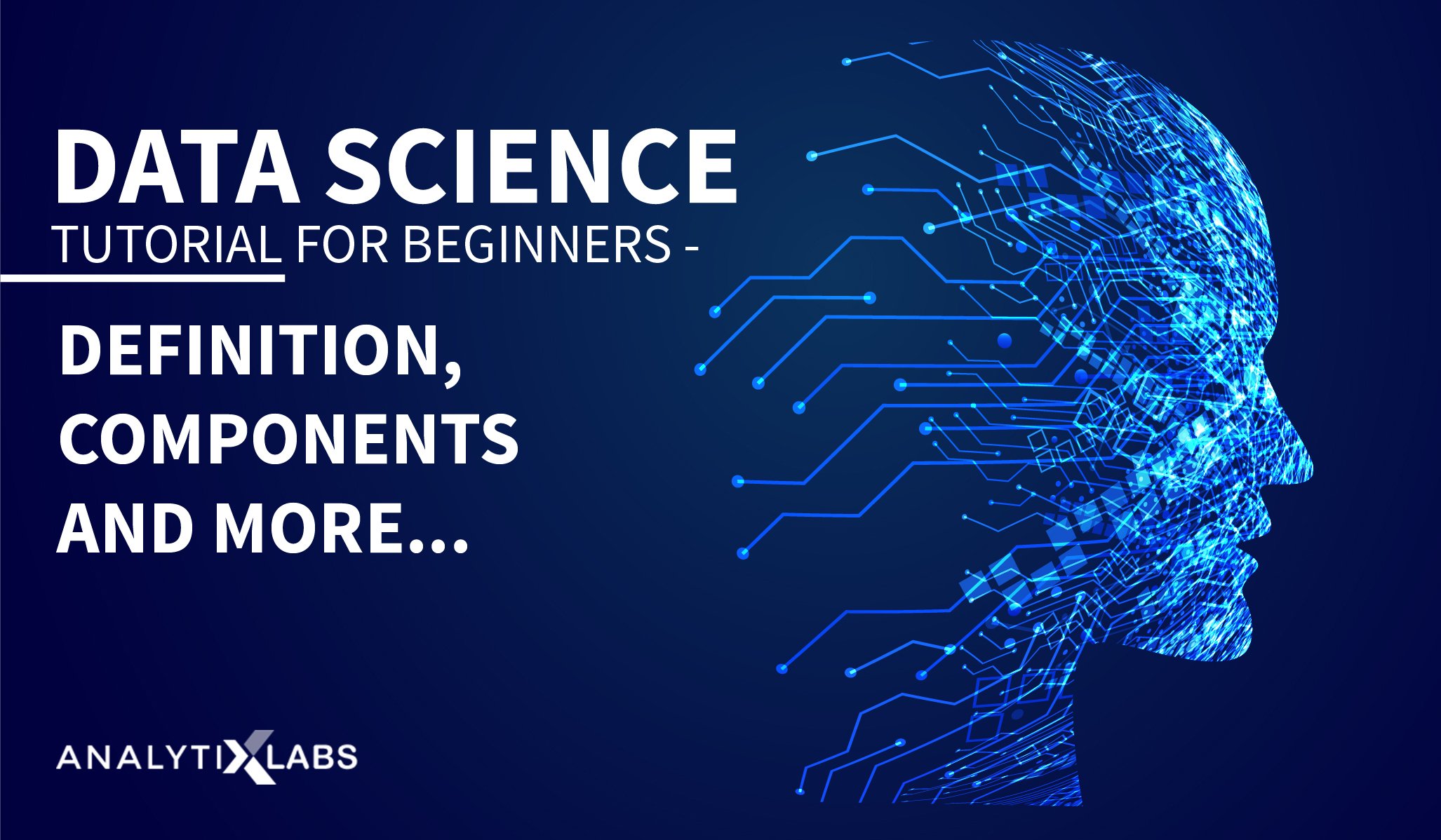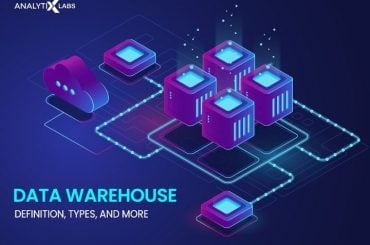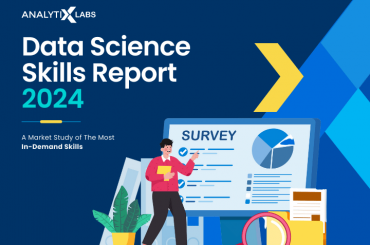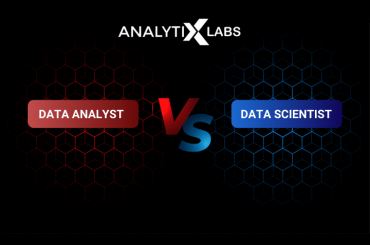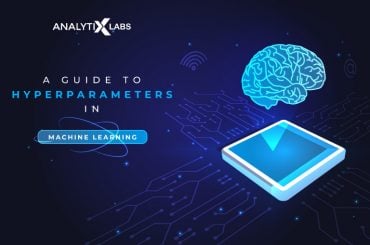This article aims to act as a Data Science tutorial and cover all the major aspects of data science. As the field of Data Science is highly spread out and complex, data science aspirants need to have a proper understanding of the various definitions, aspects, tools, and application areas of this field. Therefore, the article will allow the reader to understand Data Science and its related concepts.
AnalytixLabs is the premier Data Analytics Institute specializing in training individuals and well corporates to gain industry-relevant knowledge of Data Science and its related aspects. It is lead by a faculty of McKinsey, IIT, IIM, and FMS alumni who have a great level of practical expertise. Being in the education sector for a long enough time and having a wide client base, AnalytixLabs helps young aspirants greatly to have a career in Data Science.
Introduction: A brief about ‘What is Data Science.’
Data Science is a unique field as it is an amalgamation of multiple streams such as Mathematics, Statistics, Programming, Visuzliation, Business Interpretation, etc. However, before getting onto such aspects of Data Science, what needs to be understood is the idea behind the term “Data Science.”
Data: In the modern age, data can have multiple meanings. However, in essence, data is information. For all practical purposes, this data needs to be in numerical form, even if originally it is in some other form. As a machine can process numerical information, it would also be right to say that any information that modern-day machines, i.e., computers can process, can call data.
Science: Among the most common term found around us, science refers to the systematic study of various phenomena. This study can reproduce various theoretical concepts through experimentation, or it can be to acquire insights and more knowledge.
With the above understanding, we can understand the term Data Science in a much better manner. As Science can be related to nature, also known as natural science such as the study of physics, chemistry, space, etc. or it can be related to society and interaction of people such as sociology, anthropology, psychology, etc., it indicates towards the systematic study of concepts that includes experimentation. Therefore, when we approach data with the same level of scientific sophistication that involves properly laid down methodologies, standard operating procedures of experimentation, peer revied research that involves exploring new ways of approaching the data-based problem, this scientific study of Data is called Data Science.
Data Science Tutorial (how it can help)
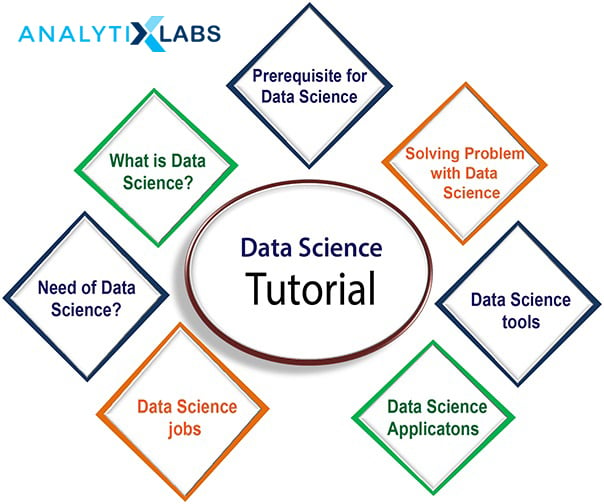
A Data Science tutorial is highly important because of the inter-disciplinary nature of this field. Data Science for a beginner is particularly tough to comprehend as there are so many components involved that belong to different fields and work in tandem. A good data science tutorial, be it in the form of a book, a dedicated blog website, an academic course, or an online/ classroom course by a learning institute, should help the learner to understand the importance and provide the appropriate depth of these concepts. A Data Science tutorial can help aspiring data scientists to understand the importance of Data Science as various domains adopt it and increasingly every major company is deciding to have a dedicated department to implement Data Science-based concepts and explore and analyze the vast reserve of data available to them. A good Data Science tutorial also helps in making the learner understand the topics that are worth paying attention to and spend time to go in-depth and also comprehend the vastness of this field without getting lost.
You may also like to read: Top 25 Data Science Books to Learn Data Science
Data Science Tutorial for Beginners
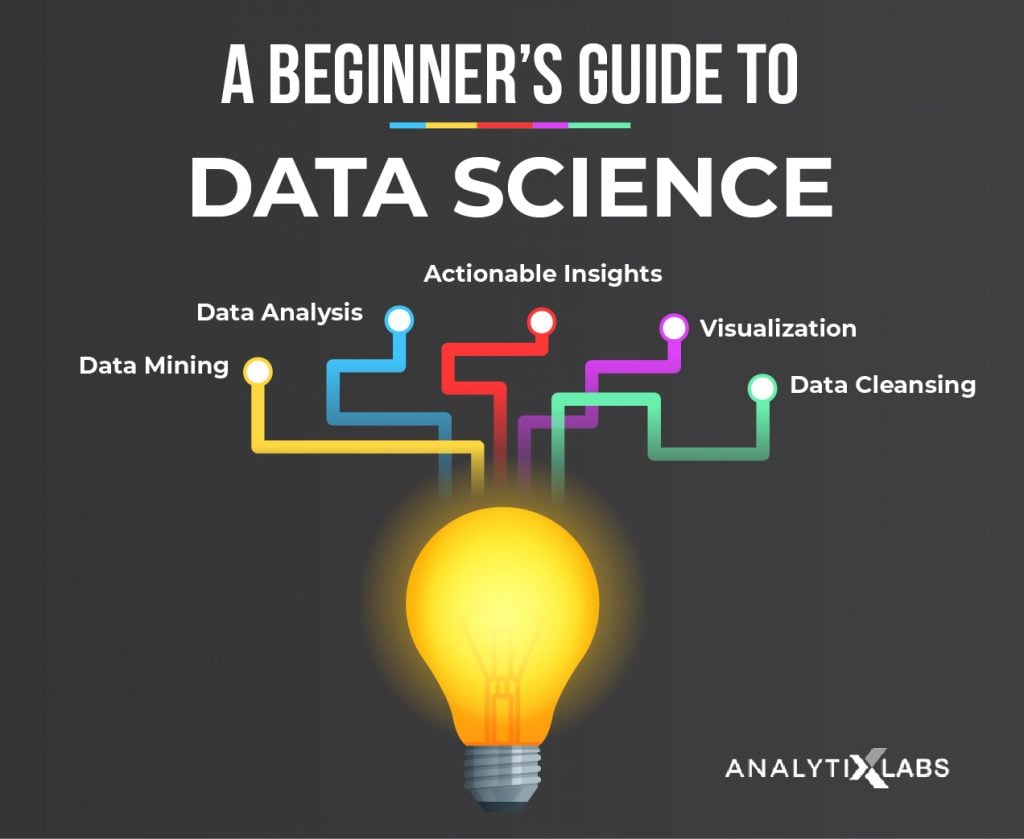
A data science tutorial for beginners is of high importance as it introduces them to this new, complex, and interdisciplinary field. As this article aims to act as a Data Science tutorial, the upcoming topics will cover all the important aspects of Data Science that a beginner needs to understand. However, before that, one must understand the delicate balance between the theoretical and application aspect of Data Science. When it comes to Data Science basics, this delicate balance is something that beginners must learn and remember.
While some fields of study are more theory intensive, there are many fields that solely focus on the application aspect of the study. Data Science on the other hand is one such field that requires the user to have both of them. For example, a Data Scientist must have a theoretical understanding of the different types of Machine Learning algorithms such as Random Forest and at the same time also must know the ways through which a model can be developed that use this algorithm.
If only the application-based knowledge is there, then the user will not be able to perform complicated procedures such as choosing the hyperparameters, providing the correct range for tuning them, and modifying the model in case faced with problems such as overfitting. Also, if there is access to only theoretical knowledge, one will never be able to properly implement their ideas, which will not yield any valuable results.
Thus, going forward as we uncover various aspects of Data Science, one must remember that there is a theoretical understanding as well as an applicative side to it too.
Additionally, Data Science for beginners can also be understood as an extension to what all they were doing with MS Excel or SQL which generally involves basic data exploration, data aggregation, etc. Here Data Science performs all those things, however, in addition to it, it also deals with the application of statistics for exploration and machine learning for creating models.
Components of Data Science
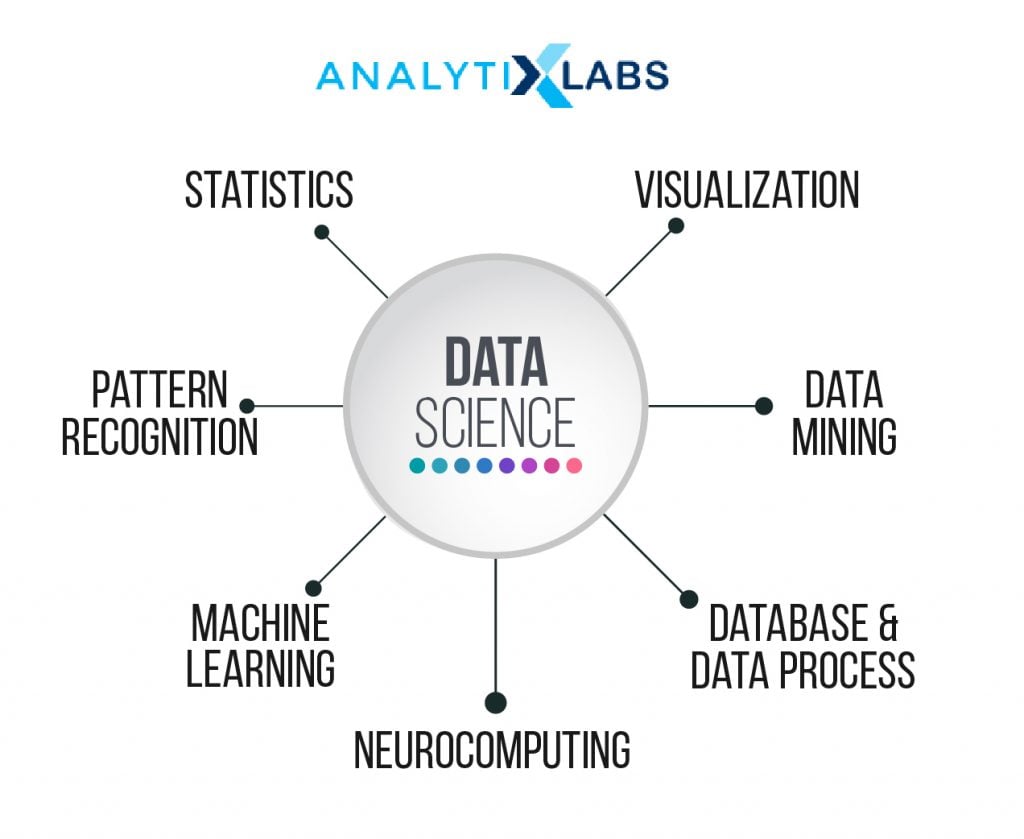
Through this article lets us understand how these various interdisciplinary fields of study allow a Data Scientist to analyze the data, gain insights from it and be able to create analytical and predictive tools that often help in major decision making. As mentioned above, all these components have their own theoretical and application side that needs to be learned in order to fully grasp the knowledge of Data Science.
1. Statistics
Considered as the backbone of Data Science, Statistics helps the Data Scientists understand the underlying patterns present in the data. Through statistics, the user can understand the relationship between various variables that helps in providing a better picture of the given data. Apart from this advanced exploratory data analysis, It also plays an important role in feature engineering, which is important for making the data prepared for most algorithms. Additionally, Statistics also acts as a checkpoint for various predictive models and gives insights into the model’s inner working, stability, and performance. Various algorithms used for creating predictive models are also based on statistics. These include algorithms such as Linear Regression, Logistic Regression, K-means, etc. So for any aspirant, it imperative to learn Basic Statistics Concepts for Data Science
2. Mathematics
Being in the age of Machine Learning and Deep Learning, Mathematics is an important aspect of Data Science. Sophisticated algorithms use advanced concepts of mathematics such as calculus and linear algebra. Therefore, having good mathematical knowledge can be considered a part of data science basics. They provide the data scientist an edge over others in terms of troubleshooting the model’s working and tweaking the performance of models using such algorithms.
3. Programming
To implement the scientific approaches to get meaningful output from data, there is a tool requirement. While various tools are available out there, most of them require the users to have some basic to intermediate knowledge of programming. The programming required for implementing data science-based concepts is not as complex as creating software from scratch, especially given the modular programming nature of these tools. A basic knowledge of programming forms the base of Data Science.
4. Business Acumen
Unlike other disciplines, Data Science is not a purely technical field, and it requires the data scientist to have a good understanding of various business domains, have problem-solving skills, and good knowledge of business problems and complexities as only then the insights gained from the implementation of Data Science can be considered useful. In Data Science, it is required not only to analyze the data but also to understand it from the prism of business problems and provide a viable business solution.
5. Reporting and Visualization
Communication forms another important aspect of Data Science. It may not be as technical as other aspects, but it still is an essential and crucial component of any Data Science project. The reason lies in the widespread use of Data Science. Given the amount of data being generated across all business sections, Data Science is implemented in almost all business domains now, which makes it important to report the analysis in simple, easy-to-understand ways as the people interested in the output may not be Data-oriented. Thus, providing visually friendly, easily comprehensible, and business logically correct analysis is of paramount importance.
Related: What is the Data Science Life Cycle? | Everything you need to know
Tools for Data Science
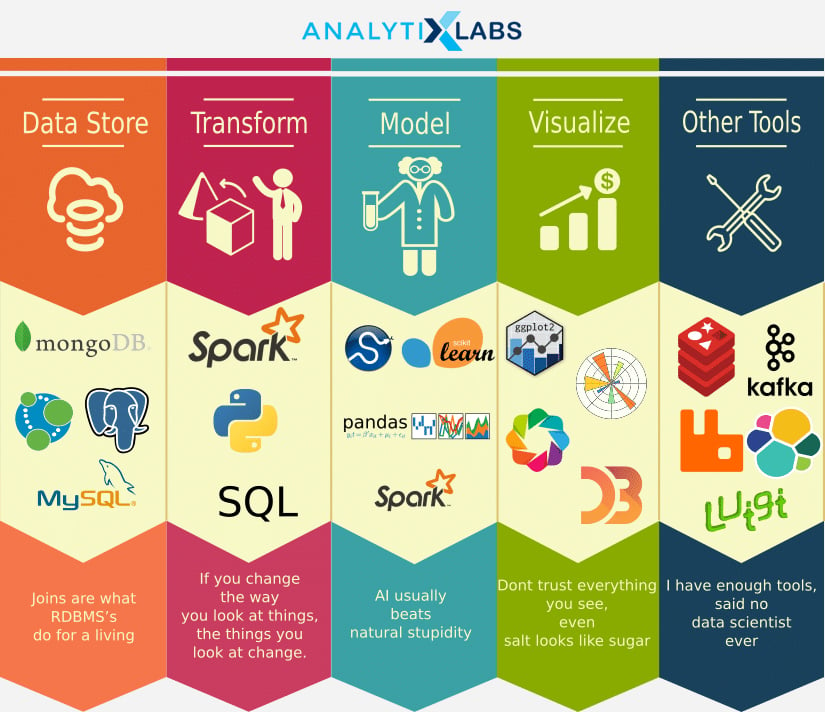
While the tools are as good as the person who uses it, Data Science related tools are subject to a high level of scrutiny, competition and is a matter of great debate. As the field of Data Science is comprised of multiple components and fields of study, there are tools that focus on specific aspects of Data Science. All data science-related tools can be divided into categories such as-
Based on the role they play in the field of Data Science:
- Collection and Storage based tools
- Analytical tools
- Reporting tools
- Modeling tools
Tools can be divided on the basis of the user experience i.e.
- GUI based tools
- Query-based tools
- Programming based tools
Also, based on the proprietorship status tools can be categorized:
- Commercial tools
- Open Source (free) tools
There are tools such as Hadoop Distributed File System and Apache Spark for accessing and storing large datasets. They are responsible for accessing a large amount of data and making it available for the user to process and analyze. These tools form the backbone of Big Data systems and require a good amount of programming knowledge from their user. Also, they have commercial options that provide benefits at a reasonable cost.
For visualization, there are tools such as MS Excel, which provide limited visualization capabilities. At the same time, there are tools such as Tableau and Power BI that primarily focus on providing users with an interactive interface to create complex graphs with much ease. These tools have free versions with limited capabilities that the users can avail of to get hands-on experience.
Numerous tools allow for the basic understanding and manipulation of data to be done easily. Among them are different types of SQL-based tools. SQL is a query-based tool and can be used to deal with data exploration, manipulation, aggregation, among other important data analysis-based aspects. SQL has commercial options along with free options. One should remember that mastering SQL for Data Science is different from learning SQL for core technical roles. In addition to this, MS Excel is also an option; however, it has limited capabilities. Other more GUI-based commercial options include Rapid Miner, Power BI, etc. Lastly, R and Python can also be used however, they are known for their model development capabilities.
Thus, when it comes to developing statistical or machine learning models, advanced programmings based tools such as R and Python are the prime contender to solve such Data Science related problems. They have the advantage of being open source and consequently free. However, they have a steep learning curve and require a decent amount of coding from the user.
A good data science tutorial must focus on the majority, if not all, of these tools. A data scientist may not be equally involved with all these aspects of Data Science, but it is expected to have intermediate knowledge of any one of these tools from each one of these fields. A good combination can be MS Excel for basic data analysis, SQL for data mining and other preparations, R or Python for advanced analytics and modeling, and Tableau for visualization and reporting. An extensive Data Science Course will typically all these concepts with appropriate depth.
Python for Data Science Tutorial
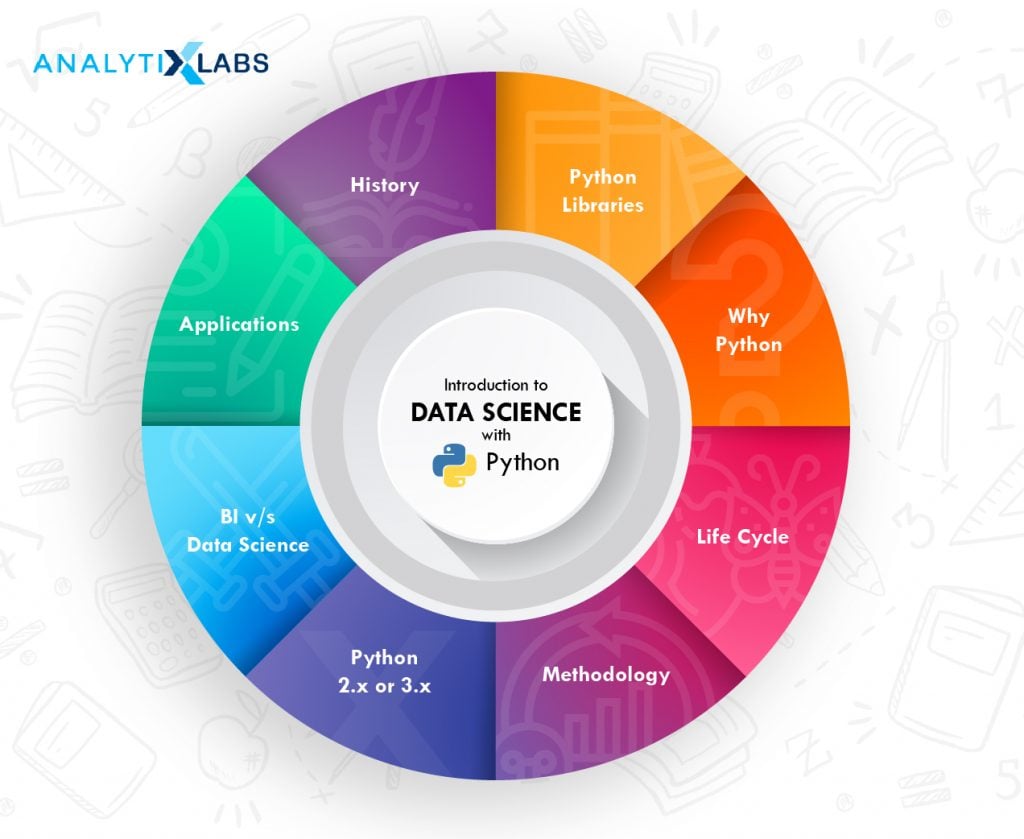
To understand the complexity of Data Science, the single tool that has the capability to cover all its aspects to a fair extent is Python. Python is scripting or commonly referred to as a programming language, as it requires a good amount of coding from the user. However, being an open-source language is free and can be used by anyone free of cost. Therefore, choosing Data Science with Python is the right decision because it has an easy learning curve and has a good amount of online material that can help self-learners or people looking to troubleshoot problems faced during the implementation of python codes.
Initially, a visual-friendly tool is important; the Jupyter notebook that can be understood as the IDE for python is apt for data science as it has capabilities of coding and reporting. Moreover, it allows the user to format text, add images and other multimedia, and create complete tutorials on topics within a single JUPYTER notebook only.
Being a modular programming tool, python provides specific packages to deal with specific aspects of Data Science. Thus to deal with data importing, exploration, and manipulation, there are libraries such as pandas that do most of the work and are an easy-to-understand library with simple, logical codes. For visualization, it has packages such as matplotlib, seaborn, and Altair, which allows the user to create industry-quality graphs; however, the coding may get complicated depending upon the complexity of the graph. Lastly, for the development of models, python provides libraries like sklearn, statsmodels, Keras, and TensorFlow that enable data scientists to create complicated statistical, machine learning, and deep learning models with a simple line of codes.
Thus, python is an apt language for a data science tutorial. It covers all the aspects through its libraries and provides the user with coding experience that can help in learning other similar languages with a bit more steep learning curve, such as R.
You may also like to read: Why Python for Data Science is Industry’s Top Choice?
Applications of Data Science
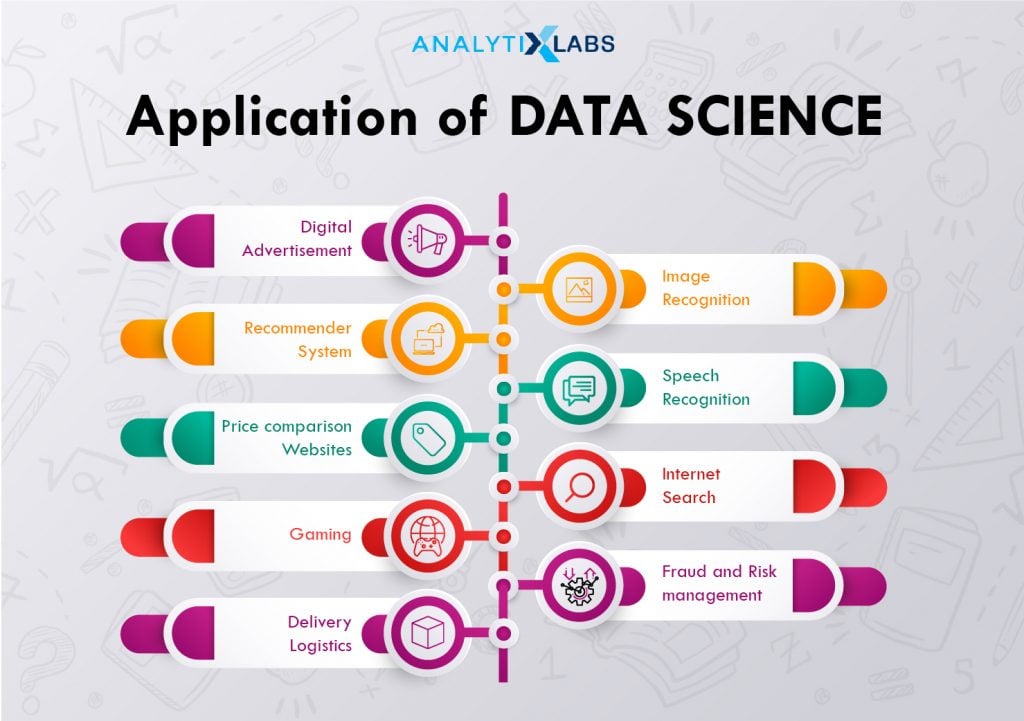
When we view the increase in the variety, velocity, and volume of data being produced on a day to day basis in the backdrop of the level of information that data hold in today’s time and the numerous business entities that produce data, it will not be difficult to guess that there are numerous application areas of Data Science. While it will be true to say that Data Science can be applied in any business domain that produces data and as all business domains produce some data, data science can be applied almost everywhere. Still, as it is impossible to talk about all the application areas, the major ones are the following:
1. BFSI Sector
Considered as the traditional applicants of Data Science, Banking, Financial Services, and Insurance has deployed tools such as SAS to mine their data and find meaningful insights from them. For example, Baking requires Data Scientists to create models to provide information on customers that can be provided with pre-approved loans. To accomplish such tasks, predictive models are to be created that consider multiple variables before deciding. Additionally, such models also provide the maximum loan amount and interest rate at which such loans can be provided. Similar concepts can be extrapolated in the fields of the insurance sector also that deals with insurance cover etc.
2. Healthcare
Among the most crucial areas where data science is applied, healthcare has increasingly become dependent on data science. Today, data science can help in reducing the time to diagnose a patient’s disease, create reports, suggesting tentative solutions to simple health-related issues, providing 24×7 assistance through an AI-enabled chatbox. The biggest revolution that Data Science has made possible is of identifying diseases before they manifest themselves in full force. This helps in saving the lives of humans suffering from diseases that seem non-threatening on the surface. Data Science also comprises computer vision that can assist the doctors in quick analysis of medical reports by detecting tumors, inflammation, and other anomalies.
3. Customer Support
Providing quick and reliable assistance to its customers has remained a prime objective of all businesses. The major issues faced during customer support are maintaining a customer assistance team, maintaining uniformity in their responses, and ensuring that correct information is passed. This issue has been greatly addressed by using Data Science that enables for more informative auto-email replies that analyze the text and provide appropriate responses. In addition, online virtual assistants in the form of chatboxes have picked up popularity in recent times as they have proven their reliability over time and again.
4. Marketing
Identifying the correct market, customers, or products to cross-sell is among the most important aspect of Marketing. Data Science through the use of classification and segmentation models allows such businesses to identify potential customers interested in certain kinds of products. This reduces the wastage of resources, such as calling customers who will have no interest in a product given their historical data.
5. Anamoly Detection
Anomaly, or as commonly known as fraud detection, has made the digital world lot safer. Data Science helps here in identifying anomalous-looking transactions from millions of transactions and automatically informing the concerned people. Because of such detections, the chances of timely knowing about a fraud preventing further losses have been made increasingly possible.
6. Travel and Hospitality
This customer-oriented sector heavily deploys data science as given the globalized world and the sheer amount of people traveling worldwide today requires sophisticated methods to keep track of all the plans. For example, airlines rely on data science to plan their routes, distribute seats on booking, manage flight delays, and identify customers’ travel patterns. Hotels also use Data Science for increasing customer satisfaction by understanding their preferences, providing them with appropriate rooms, seamlessly maintaining the rescheduling of bookings.
7. Loyalty Programs
As the competition increases, so does the chances of customer churn and customers getting engaged with the competitors. This requires the business today to make sure that they retain their valuable customers. This, in turn, gives birth to heavily data-based loyalty programs. By analyzing the data, a business can decide what benefits to provide to different kind of customers, how to encourage customers to do more business with them, and making sure that the programs are not designed in such a way that they benefit certain customer more and leave out deserving customer making them dissatisfied.
8. Sports
Among the lesser know application areas, Sports heavily deploys data science for numerous purposes. For example, coaches and team managers rely on data science to identify those underdog players that have the potential but are getting lost due to the availability of large numbers of players worldwide. This helps in bringing new talent to the forefront. Other usage includes tracking how the players perform, analyzing their performance to help them perform better, and even predicting a team’s performance given the combination of certain players.
9. Security
Law Enforcement and other security agencies rely on data science to protect their people. Methods of fingerprint matching and facial recognition have become much more efficient and reliable. Security gadgets are now being created that detect motion and can send SOS alerts to the concerned people in case of illegal trespassing. To find crimes, law enforcement officials often have to go through a large amount of data such as bank records, telephone activities, and testimonies to detect patterns that can help solve the case, which can also be done through the implementation of Data Science.
10. Mining
The most recent addition to the growing list of data science users, the mining industry, has started relying on data science to identify the locations where natural resources can be found. However, the current, non-data science-based method is expensive, which requires teams to manually dig and test the soil for potential sites for future full-scale mining. Data Science can help the engineers by analyzing historical data, current soil and climate conditions, among other variables, and provide them with the potential sites, the type of resources and minerals available there, along with details on their composition and quantity. This can help the industry in reducing the cost.
Conclusion: Authors opinion
In conclusion, a Data Science tutorial covers all the major aspects of data science, such as storing, importing, exploring, and methodologically analyzing data. Such a tutorial must also focus on all the major data science-related tools. This article aimed to talk about the various sub-field within the larger field of Data Science, and a beginner must spend time learning all these aspects. As the tools play an important role in this field and are designed to accomplish specific aspects of Data Science related projects, aspirants must learn the major tools. Lastly, having a decent business understanding and knowing the major application areas of Data Science must be analyzed. It is important to have a pragmatic view of the application areas.
FAQs – Frequently Asked Questions
- What is data science tutorial?
A Data Science tutorial provides a proper introduction to Data Science. It provides an in-depth understanding of this inter-disciplinary field by focusing on the theoretical and application (tools) aspects. Data Science tutorial can be helpful for beginners as it allows them to get familiar with the Data Science basics and gives them an understanding of how Data Science can create a major impact in real-world decision making.
- How do I start studying for data science?

There are multiple ways of studying Data Science. Some of them are the following:
a. Academic Courses
There are numerous Indian, American, and European colleges and universities that provide academic courses for Data Science. While these courses generally have good credibility and impart a good amount of knowledge, they are highly competitive, and getting a place is difficult. Also, it is the most expensive option to study Data Science.
b. Online Courses
The next option is Online Courses. There are multiple platforms such as AnalytixLabs, Coursera, Udemy, EdX, etc that provide numerous online certification courses that cover numerous aspects of Data Science using different tools. The advantage of this option is that it is inexpensive or less expensive than an academic course. In addition, it is available to almost everyone; however, its disadvantages include the impersonal form of teaching where the learner cannot necessarily interact with the trainer on a continuous basis.
c. Educational Institute
A great option is an educational or training institute that provides certification in Data Science. As there are numerous institutes, a challenge could be to find a good one. However, certain indicators of a good institute, such as an experienced faculty with industry knowledge, modules that cover all major aspects of Data Science, and a good balance between the theoretical understanding and the application of them through common widely applied tools such as R and Python. Also, apart from its cost-effectiveness, comprehensive data science learning materials, or PG Data Science course can provide classroom learning or live online options, which can greatly help data science beginners expose themselves to greater knowledge.
- How can I learn Data Science for free?
Apart from all the methods of learning about Data Science mentioned above, there is one more way to learn Data Science on your own. This is the most inexpensive and virtually free option (if you do not include the cost of the internet). One can learn Data Science for free by joining various free online courses provided by Coursera or Udemy. In addition to this, numerous YouTube channels provide a good amount of knowledge on Data Science. Also, there can be free e-books and online blogs that focus on specific aspects of Data Science. However, while this method is highly inexpensive, it can risk the user going in the wrong direction, learn unnecessary things, prepare for Data Science interviews with incomplete knowledge, or get exhausted because of not being guided properly.
- What are the 8 steps to becoming a data scientist?
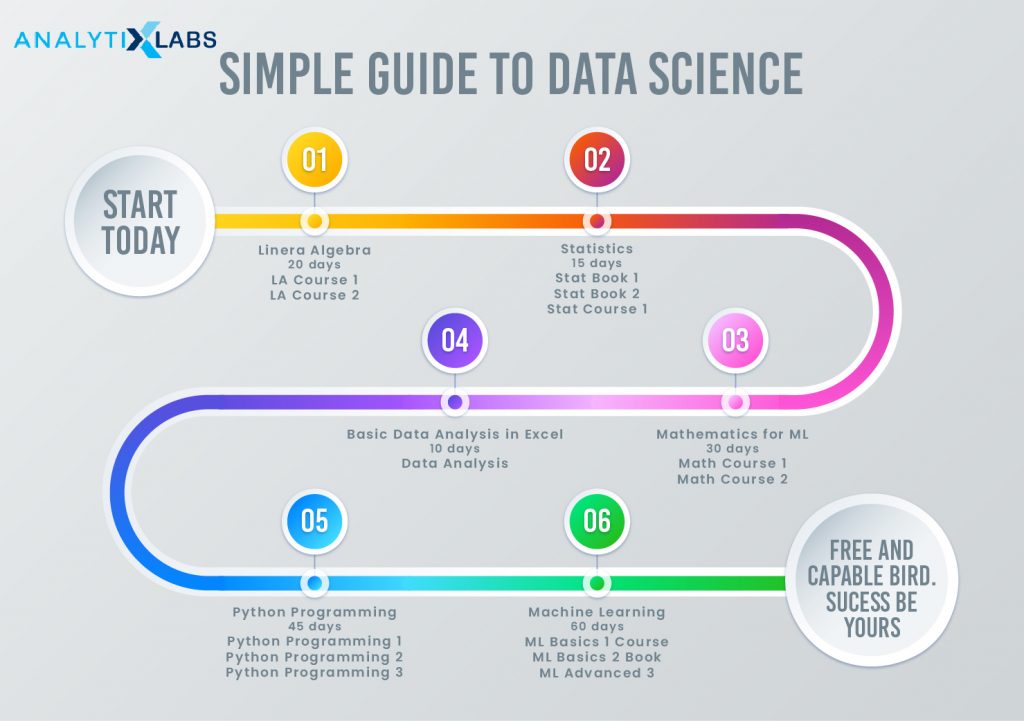
a. Understanding the field of Data Science
The first major aspect is to have a holistic understanding of this field. This includes understanding the role of various components of Data Science such as statistics, mathematics, programming, business knowledge, reporting, etc. Also, know the role they play in the functioning of a Data Science-based project.
b. Getting exposed to structured data using simple tools
As data science deals with mostly structured data (and even unstructured data that is eventually converted to become structured), it is important to familiarize yourself with basic data-related operations. These can be best understood and explored through the use of simple GUI-based tools such as Excel as it allows the user to view the data and interact with it in a much easier manner, helping the user understand the structure of a typical dataset.
c. Learning Basic Statistics
Statistics play an important role in Data Science, and therefore Data Science aspirants need to have a good theoretical knowledge of it. The immediate concepts that must be known are related to Descriptive Statistics, including measures such as Measure of Central Tendency, Measure of Variability, Measure of Shape, etc. In addition to this, in advanced stages, knowing inferential statistics is important, and this is where the knowledge of hypothesis testing and its related concepts is required.
d. Learning Basic EDA, Data Manipulation and Visualisation on simple to intermediate tools
Once basic tools are used to hang typical datasets, it becomes important to start exploring and manipulating datasets. This is where tools such as SQL can come in handy. For visualization, MS Excel, or creating sophisticated graphs, then Tableau should be learned and implemented. If required, one can move to other advanced tools such as Python and R also, however for that, their basic understanding is required.
e. Practicing programming and learning basic of a language such as R or Python
As mentioned above, to kick start and learn the various data exploration and manipulation based advanced tools such as R and Python, their basic understanding is required as it can ease the learning curve. Without understanding the syntax and other programming rules of such languages, the user may get forced to memorize the syntax for performing various operations which can greatly hinder the learning process. Also, learning the programming basics of these languages provide more freedom to the user as it gives them the capability to create their own functions.
f. Familiarising with the theoretical concepts of modeling – algorithms, model development, evaluation, and validation
The major aspect of Data Science is the development of models. While given today’s modular programming where libraries or packages allow the user to create a model in mere 3-4 lines of code, it’s the theoretical understanding of how the algorithm function behind the model. Here learning the inner function of the algorithm allows the user to increase the performance. In addition to this what all data preparation, feature engineering steps are to be taken for developing a model is also something to be understood. Lastly, once a model is created, the user needs to learn the various metrics through which its accuracy can be implemented and learn the concepts of Overfitting, Multicooliniearity, Curse of Cimetnioanly, and the ways to solve them through the use of Cross-Validation, etc.
g. Participating in Hackathon and solving case studies
There is a requirement of industry-relevant datasets on which analysis can be done, or models can be developed to apply all the above-mentioned knowledge. However, until and unless the knowledge is not used to solve practical problems, the gaps in the understanding of Data Science related concepts will not be exposed. To get a pragmatic view of things, one can enroll in the various online hackathons. If they learn about Data Science through some online or other certification courses, they can work on their provided assignments and case studies.
h. Securing a job in the field of Data Science
Lastly, once all the relevant knowledge is achieved, the aspirant must start with the interview preparations. They must go through various Data Science related interview material readily available online, partake in as many data science-based quizzes as possible. The aspirants mustn’t shy away from sitting in interviews as this would give them the required confidence and exposure to crack an interview and become a Data Scientist finally.
This article aimed at providing the reader with an understanding of the field of Data Science, its components, the general pitfalls, and common mistakes that beginners make while also exposing the reader to the various tools associated with this field and its importance in present times. If you have any opinions or queries related to this article, please feel free to post and help us get more insights.
You may also like to read:
1. Top Data Science Courses & Free Learning Resources 2021

